Hampi, the erstwhile capital of the Vijayanagara Empire, is an open-air museum brimming with architectural marvels. Among these gems, the Achyutaraya Temple stands out as a testament to the empire’s grandeur and artistic prowess. This magnificent temple, dedicated to Lord Tiruvengalanatha (a form of Lord Vishnu),[1] is a treat for history buffs, devotees, and admirers of architectural marvels. In this article, we will delve into the captivating allure of Achyutaraya Temple, taking a closer look at its history, architecture, and the spiritual experience it offers to visitors.
This temple located at the foot of Matanga Hill, just to the west, and situated between Gandhamadhavana and Matanga Hills. It is approximately 1 kilometer away from the Hampi Bus Stand.
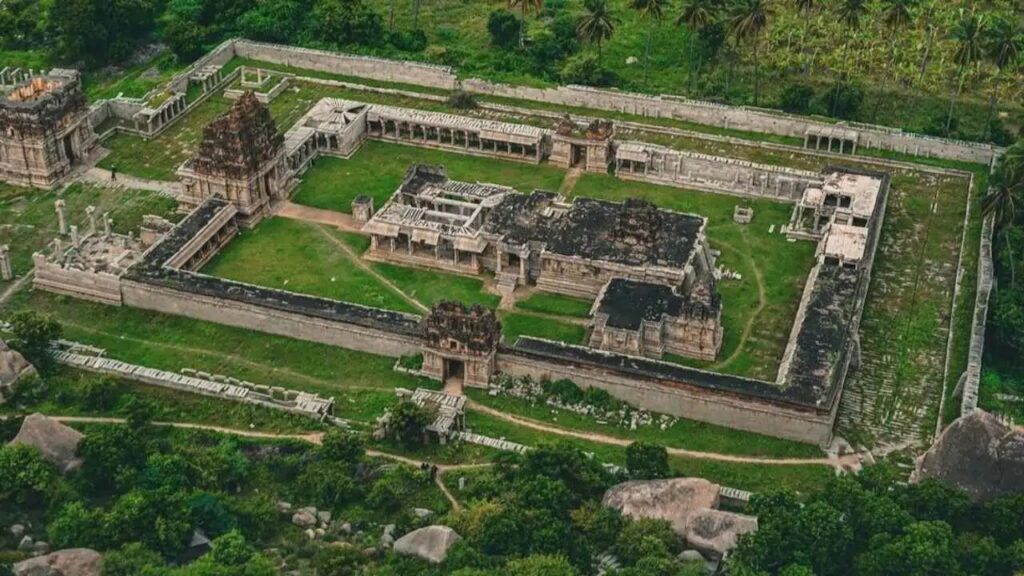
Table of Contents:-
The Achyutaraya Temple is situated in a secluded location away from the more traveled paths, resulting in fewer crowds compared to many other tourist attractions in Hampi. This is excellent news for visitors seeking peaceful tours, as the temple’s off-the-beaten-path location and hidden nature contribute to its serene and uncrowded ambiance.
This Temple stands as a magnificent testimony to the glorious past of Hampi and the Vijayanagara Empire. From its rich historical significance to its awe-inspiring architecture, every aspect of this temple invites visitors to embark on a journey through time. Whether you are a history enthusiast, a devotee, or simply a traveler seeking to marvel at architectural marvels, Achyutaraya Temple promises an unforgettable experience. So, step into the realm of ancient wonders, immerse yourself in the spiritual aura, and let Achyutaraya Temple in Hampi leave an indelible mark on your soul.
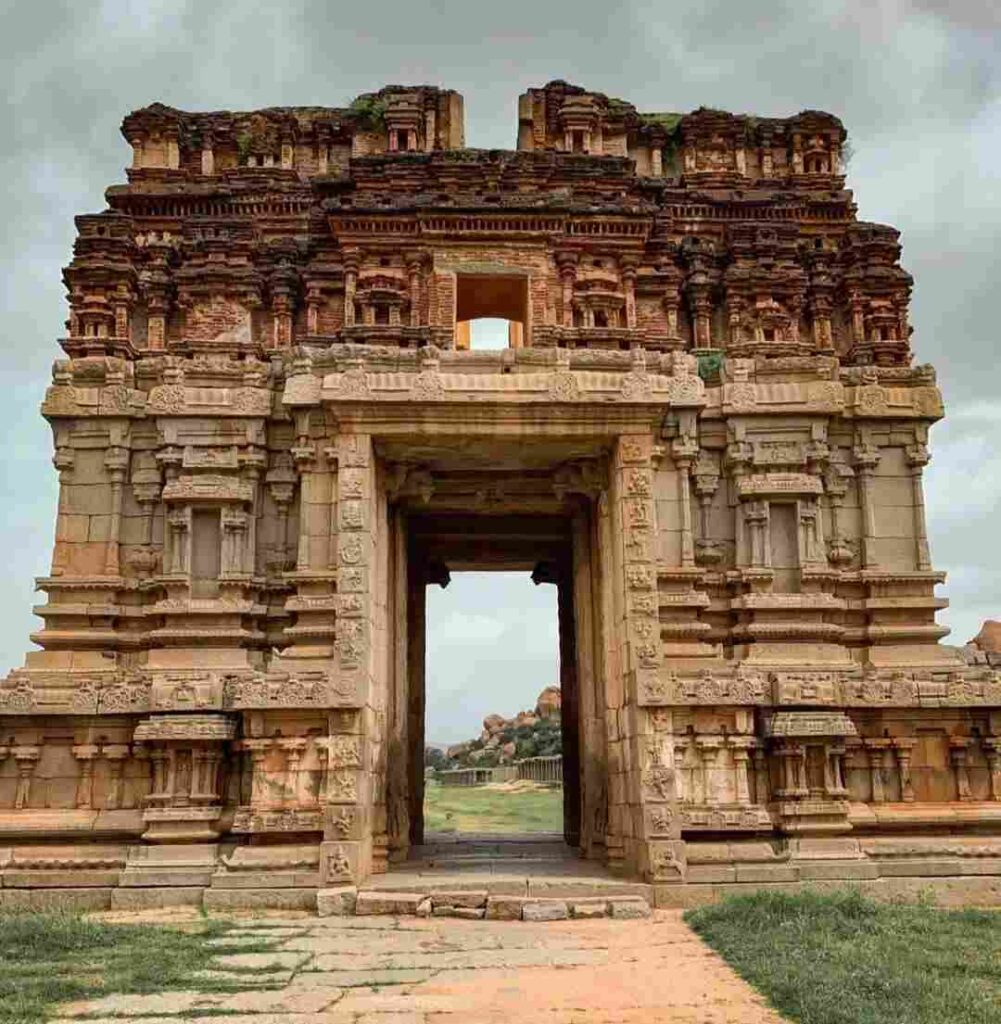
Quick Facts
- Timing: 06:00 AM to 06:00 PM
- Entry Fee: No entry fee required
- Photography: Allowed
- Location: Google Maps
- Must-See Attractions
The History of Achyutaraya Temple
This temple, constructed in 1534 AD by Hiriya Tirumalaraja, the Mahamandaleshwara, who served as a high officer in Achyuta Raya’s court under the Vijayanagara king Achyutaraya (1599-1542 AD), exemplifies an advanced form of the Vijayanagara style of architecture. It was one of the last grandiose temple projects executed in the capital before the fall of the empire. Dedicated to Lord Tiruvengalanatha, a form of Vishnu, the temple showcases intricate craftsmanship and architectural brilliance.[1]
Architecture and Design
The Achyutaraya Temple is renowned for its exquisite Dravidian architecture, characterized by intricately carved pillars, ornate sculptures, and towering gopurams (entrance towers). The temple complex is adorned with stunning bas-reliefs depicting scenes from Hindu mythology, showcasing the craftsmanship and attention to detail of the artisans of that era.
Located between Gandhamadhavana and Matanga Hills, the temple complex is accompanied by a ruined market street. Notably, the open hall in the vicinity showcases some of the finest carved pillars found in Hampi. The main temple structure comprises a Garbhagriha, Sukanasi, Antarala, Rangamantapa, and a spacious pillared Mahamantapa. Adjacent to the main temple, towards the southwest, lies the Devi shrine.
Of particular note is the enclosure of the temple complex with two Prakaras, with the temple positioned centrally within the inner Prakara. The inner Prakara boasts three grand entrances (Mahadwaras), while the outer Prakara features a single imposing entrance, predominantly on the northern side. Both Prakaras are lined with series of Mantapas adorned with intricately carved pillars along their facades. Running from the front of the northern Mahadwara is the Achyutarayapete, flanked by pillared Mantapas on either side.
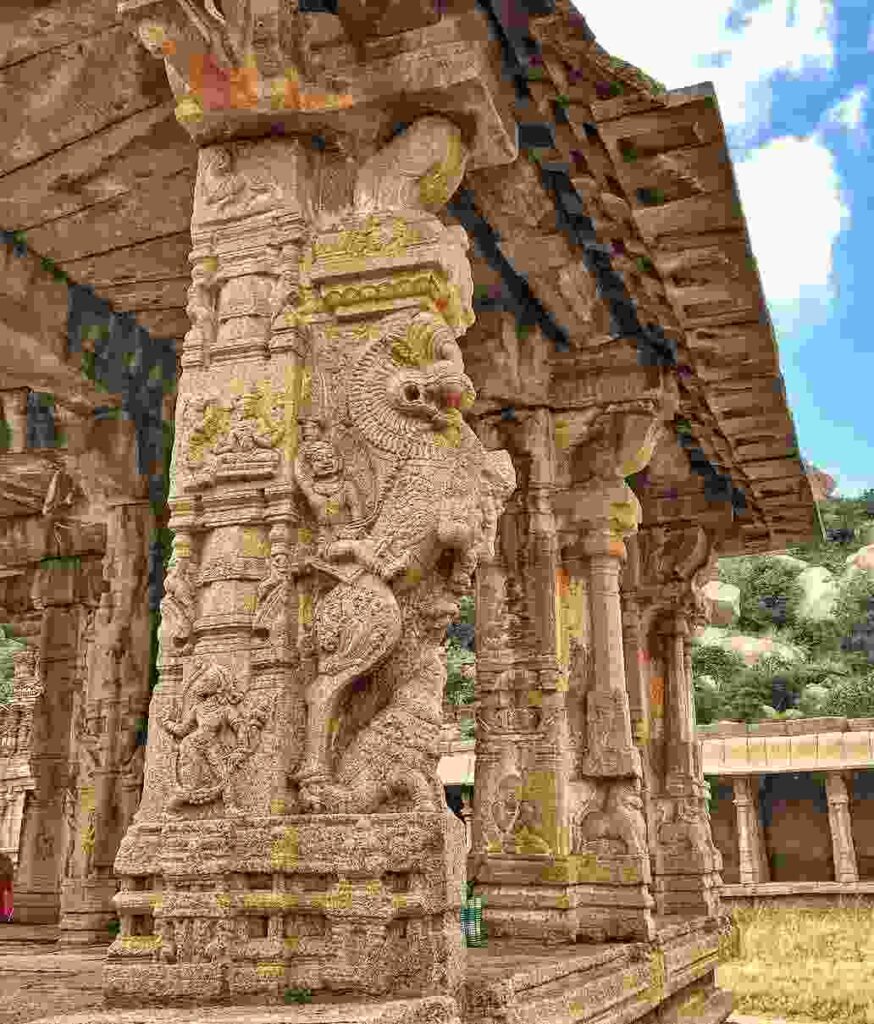
Achyutaraya Bazaar
The temple complex of Achyutaraya is fronted by this car street, also known as Courtesan’s Street (Soole Beedhi), measuring nearly 375 meters in length. It has been identified as having been a busy trading centre. jeweler’s casket containing precious ornaments was found in the floor of an Mantapa; it had perhaps been hurriedly buried during the in vasion of the capital 1565.[2]
The car street is lined by mantapas on either side and has a large, ornate, stepped pushkarani at its northern end. Closer to the Achyutaraya Temple, the mantapas have a wide flight of steps which probably let people access their roofs and watch he festivities in the car street. Facing the tank composite-based lion pillar, with a colonette at the shaft that supported a heavy eave, can be found.

Pushkarani
This sacred tank of the Achyutaraya temple dates back to 1534, and stands on the western side of the car street mantapas. It diers from other such tanks in that it was probably used more for Vasantotsava rather than Teppotsava.
It is shallow, with a well-paved floor, this allowed devotees to wade across to the central pavilion that housed the processional deity. A control system at the north-western corner maintained the water level at a height suitable or wading The central pavilion stands on an ornate platform. Its kantha is treated with a low relief of caparisoned elephants, surmounted by an Adhopadma moulding. The square pillars bear Vaishnava sculptures. The tank is surrounded by a pillared pavilion with entrance passages at the North and South.[3]

Must-See Attractions at Achyutaraya Temple
Hampi, an open-air museum brimming with architectural marvels, boasts the Achyutaraya Temple as a testament to the Vijayanagara Empire’s artistic genius. This magnificent temple, though in ruins, offers a captivating glimpse into the bygone era. Beyond its historical significance, the Achyutaraya Temple complex itself holds a treasure trove of must-see attractions that beckon explorers and history buffs alike. Let’s delve deeper into what awaits you:
Architectural Splendor: A Journey Through Vijayanagara Craftsmanship
The Achyutaraya Temple exemplifies the Vijayanagara style of architecture in its most evolved form. Stepping into the complex is like stepping back in time. Here’s a breakdown of the key architectural elements that deserve your attention:
a) Concentric Enclosures:
The temple complex boasts two concentric rectangular enclosures, each marked by an imposing entrance tower (Gopura). These Gopuras, adorned with intricate carvings depicting deities and mythological scenes, serve as grand gateways to the inner sanctum.
b) The Inner Sanctum:
Once the heart of the temple, the Garbhagriha housed the main idol of Lord Tiruvengalanatha (a form of Lord Vishnu). Though the idol is missing today, the meticulously carved pillars, painstakingly restored by the Archaeological Department of India, stand as a testament to the temple’s artistry. Imagine the grandeur of the idol once placed here, radiating divinity within the sanctum.
c) Connecting Halls:
The Garbhagriha is connected to the outer hall by a series of connecting chambers – the Antarala (vestibule), Sukanasi (pillared hall), and Ranga Mantapa (main hall). Each hall boasts unique architectural features, with pillars showcasing intricate designs and friezes depicting stories from Hindu mythology.
d) The Kalyana Mandapa:
This elaborately decorated hall, likely used for wedding ceremonies or special occasions, is a visual treat. Imagine the vibrant colors and bustling activity that might have filled this space centuries ago. Look for intricate carvings on the walls and pillars, depicting scenes from Hindu epics or celestial beings.
e) Achyutaraya Pushkarani:
Be sure to visit the Achyutaraya Pushkarani, a rectangular stepped tank considered one of the most elegant in Hampi. This architectural marvel features a central pillared pavilion and rows of decorative pillars lining the tank.
f) Gopurams:
Stand in awe of the towering gopurams at the entrance of the temple complex, adorned with elaborate sculptures and ornate decorations, showcasing the architectural splendor of the Vijayanagara Empire. As you pass through these gateways, you’ll feel a sense of awe and anticipation, knowing that you are about to embark on a spiritual and architectural journey like no other.
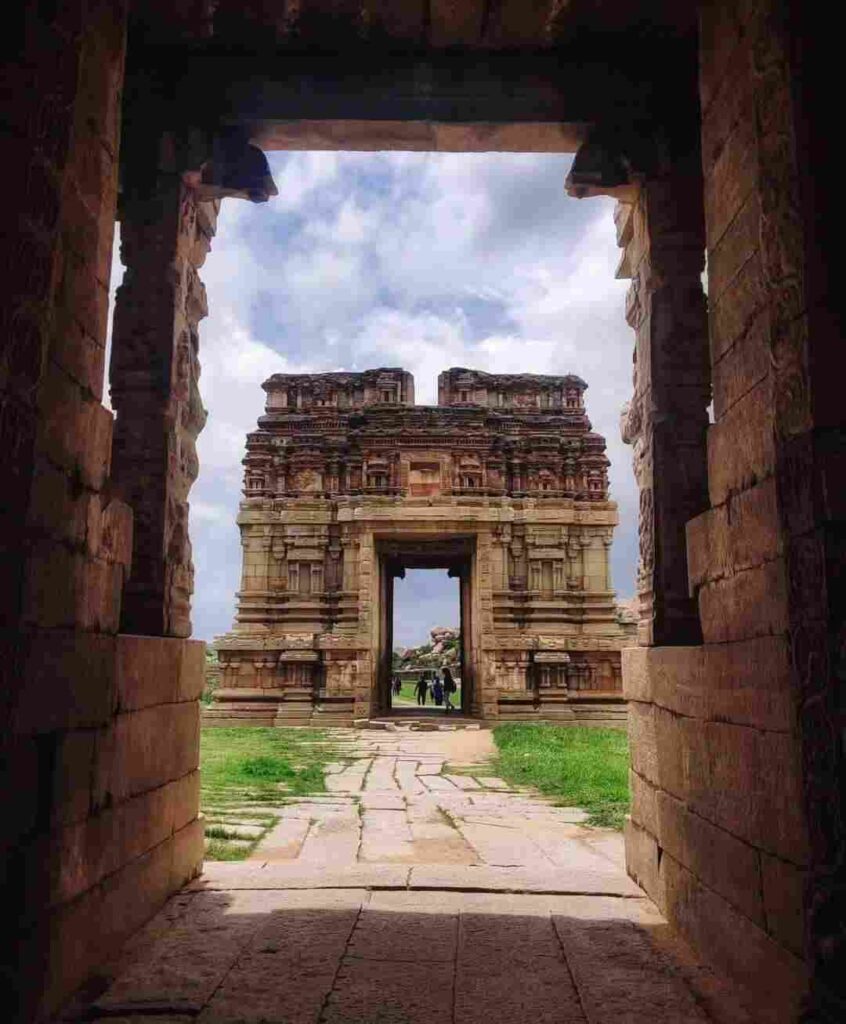
A Canvas of Carvings: Unveiling the Stories
The Achyutaraya Temple is a veritable canvas adorned with intricate carvings that tell stories waiting to be unveiled. As you explore the complex, take time to appreciate the artistry embedded in these carvings:
a) Mythological Tales:
Scenes from Hindu epics like the Ramayana and Mahabharata come alive on the temple walls. Look for depictions of Lord Vishnu’s avatars, battles between gods and demons, and tales of celestial beings. These carvings offer a window into the religious beliefs and mythology of the Vijayanagara era.
b) Floral Patterns and Decorative Motifs:
Beyond the mythological scenes, the temple is adorned with intricate floral patterns, geometric designs, and other decorative motifs. These carvings add a layer of aesthetic beauty to the architectural elements, showcasing the artistry of Vijayanagara craftsmen.
c) Secular Scenes:
Interestingly, some carvings depict scenes from everyday life during the Vijayanagara Empire. You might find depictions of dancers, musicians, and even royal processions, offering a glimpse into the social life of the era.

A Spiritual Sanctuary: A Place for Reflection
Beyond its historical significance, the Achyutaraya Temple offers a space for spiritual reflection. The serene atmosphere, the intricate carvings depicting deities, and the whispers of history all contribute to a sense of tranquility:
a) Smaller Shrines:
Venture beyond the main temple complex, and you’ll find a network of smaller shrines and temples scattered throughout the landscape. These hidden gems, dedicated to various deities, weave a rich spiritual tapestry around the Achyutaraya Temple.
b) A Living Legacy:
While the Achyutaraya Temple is no longer a place of active worship, its enduring presence serves as a reminder of the vibrant religious life during the Vijayanagara Empire. Imagine the daily rituals, the chanting of hymns, and the throngs of devotees who once filled this space with devotion.
Exploring the Surroundings of Achyutaraya Temple
Achyutaraya Temple isn’t just a historical marvel, it’s a portal to a bygone era nestled amidst the captivating ruins of Hampi. Here’s a deeper look at the temple’s captivating surroundings:
Panoramic Vistas:
Towering over the temple complex are Matanga Hill and Gandhamadana Hill. Matanga Hill, the highest point in Hampi, beckons with breathtaking panoramic views of the entire Vijayanagara city, the Tungabhadra River snaking like a silver ribbon through the landscape. Legend whispers tales of Matanga Muni, a sage who resided here.
Architectural Symphony:
Step outside the temple complex and find yourself amidst a symphony of Vijayanagara architecture. The vibrant Hampi Bazaar, a bustling marketplace overflowing with local crafts and souvenirs, lies close by. A short walk takes you to other architectural gems like the Hazare Rama Temple, a masterpiece adorned with intricate carvings, and the Vittala Temple, famous for its iconic stone chariot, and Virupaksha Temple, Hemakuta Hill Temple Complex. Exploring these marvels allows you to create a rich historical itinerary, piecing together the grandeur of the Vijayanagara Empire.
Nature’s Embrace:
The mighty Tungabhadra River flows majestically near the Achyutaraya Temple, its serene presence adding a touch of tranquility to the historical setting. Imagine offering prayers at the temple while the gentle murmur of the river fills the air, creating a moment of perfect harmony between nature and spirituality.
Spiritual Tapestry:
Venture beyond the main temple complex, and you’ll find a network of smaller shrines and temples scattered throughout the landscape. These hidden gems, dedicated to various deities, weave a rich spiritual tapestry around the Achyutaraya Temple. Encountering sadhus (holy men) on their pilgrimages adds to the spiritually charged atmosphere, making your visit a truly immersive experience.
Tranquil Escape:
Despite its proximity to the bustling Hampi Bazaar, the Achyuta Raya Temple itself offers a surprising sense of peace. The vast expanse of the ruins allows for quiet exploration and reflection. Wander through the temple complex, marvel at the intricate carvings, and lose yourself in the grandeur of a bygone era. Here, amidst the whispers of history, you’ll find a haven of tranquility, a perfect setting to contemplate the enduring legacy of Hampi.

Navigating to Achyutaraya Temple
Navigating to Achyutaraya Temple is a journey filled with historical wonder and architectural marvels. Located amidst the captivating landscape of Hampi, this iconic temple offers visitors a glimpse into the rich heritage of the Vijayanagara Empire. To reach the temple, one can embark on various routes, each presenting its own adventure and scenic beauty.
Reaching Achyutaraya Temple from Hampi Bus Stand:
For most visitors, the Hampi Bus Stand serves as the main entry point. Reaching the Achyutaraya Temple from here is a breeze. If you enjoy exploring at your own pace, consider a leisurely walk (approximately 1 kilometer). Head towards Hampi Bazaar, a bustling marketplace, and continue straight through it until you reach the temple complex. Alternatively, you can reach this temple complex via the Kampabhupa Path, bypassing Chakratirtha and Kodandarama Temple. This walk offers a chance to soak in the local atmosphere and takes about 15-20 minutes.
Reaching Achyutaraya Temple from Vitthala Temple:
To reach Achyutaraya Temple from Vitthala Temple (approximately 1.5 kilometers), exit the Vitthala Temple complex and head south towards the main road. Continue southward until you reach the vicinity of Matanga Hill, then proceed westward along the road. Look for signs indicating the direction to Achyutaraya Temple or ask locals for guidance. Follow the directional markers until you arrive at Achyutaraaya Temple.
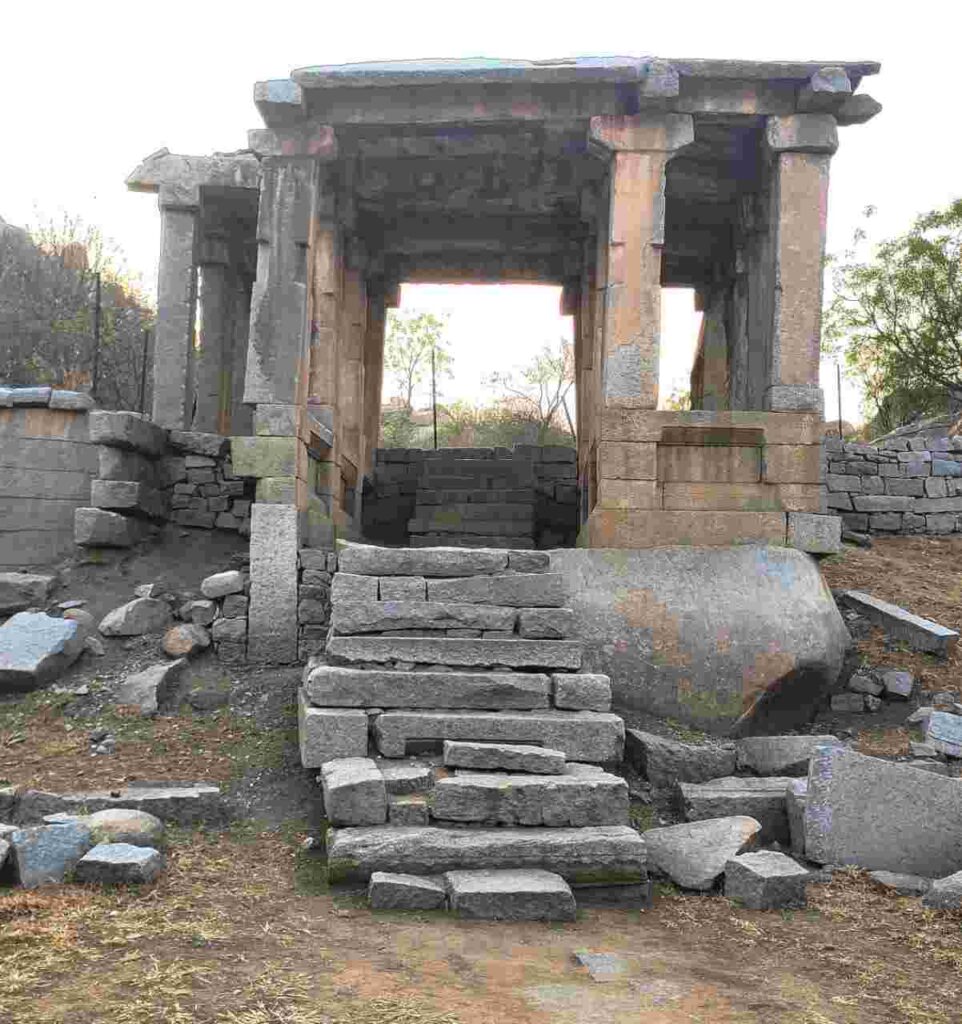
Gallery:-
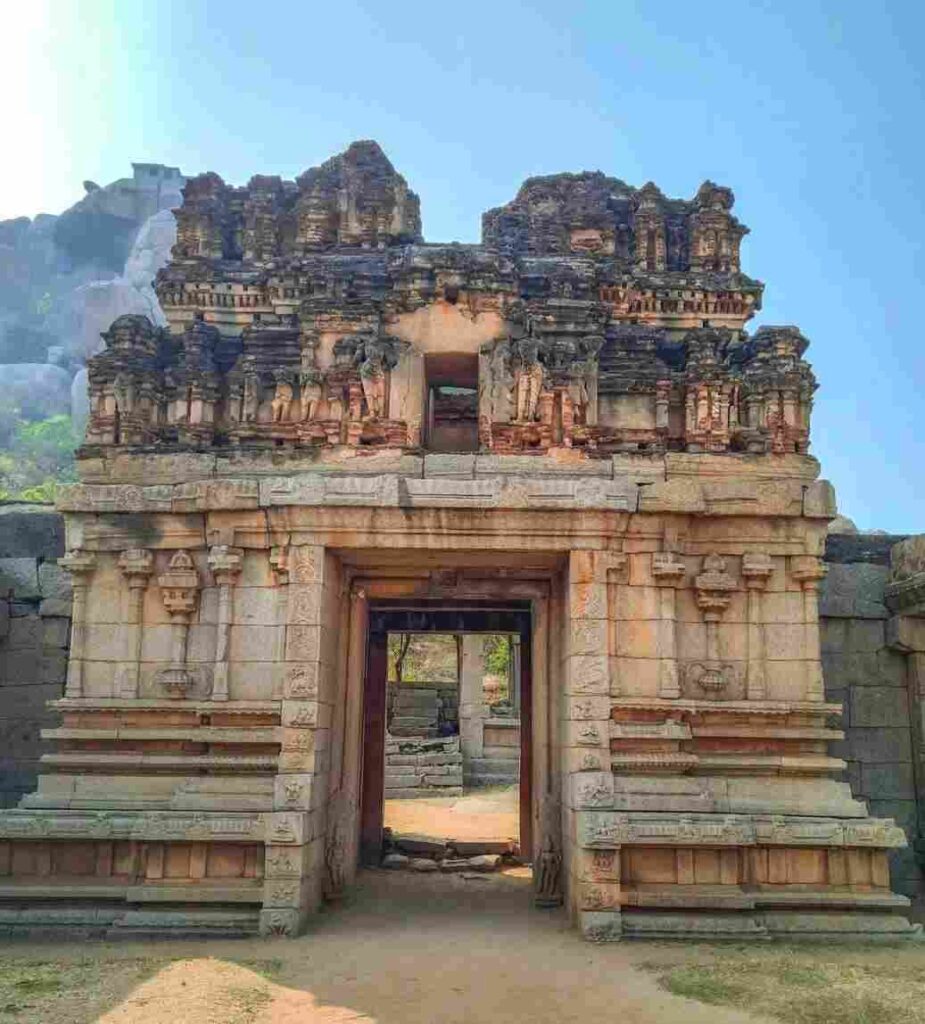

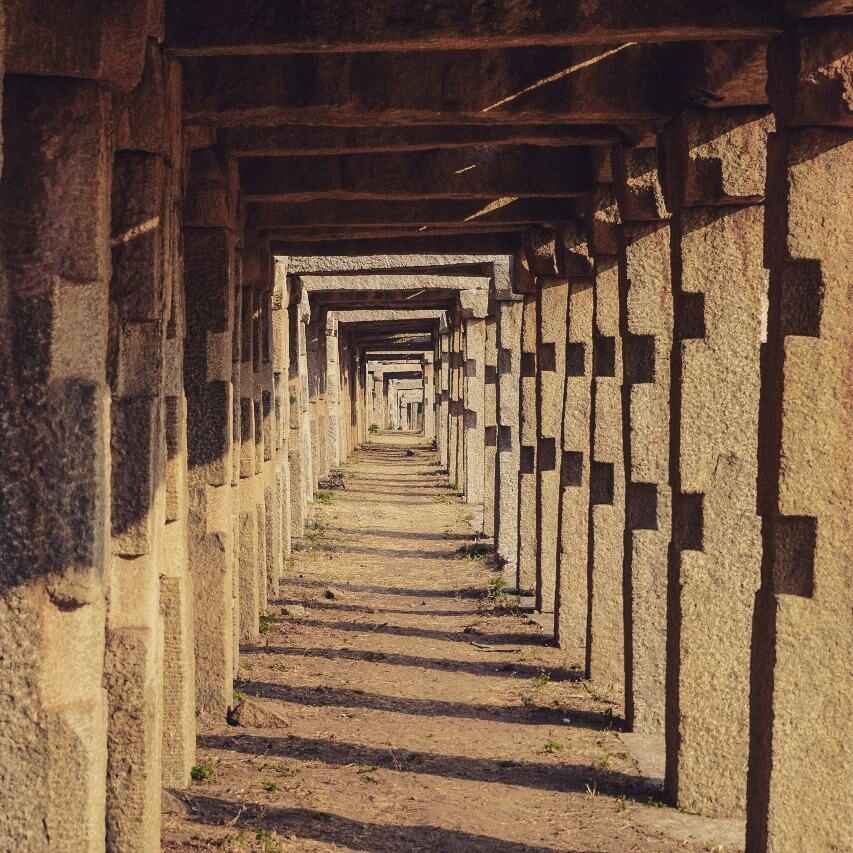
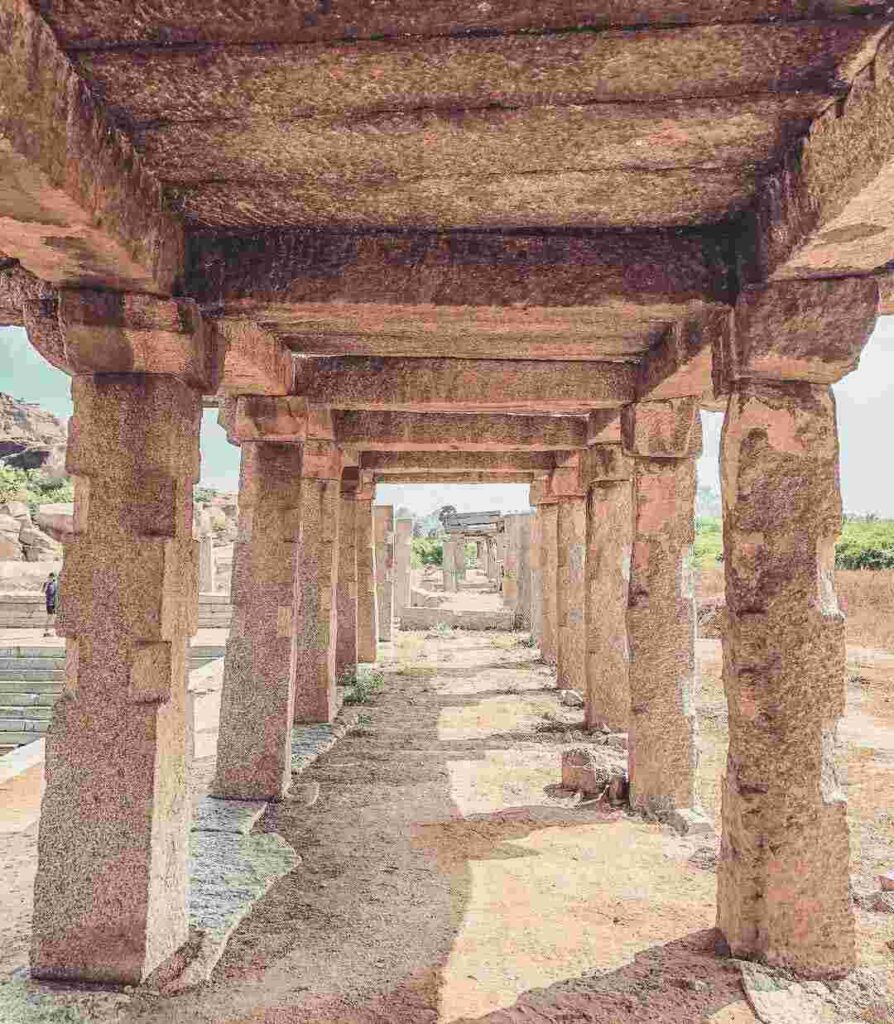

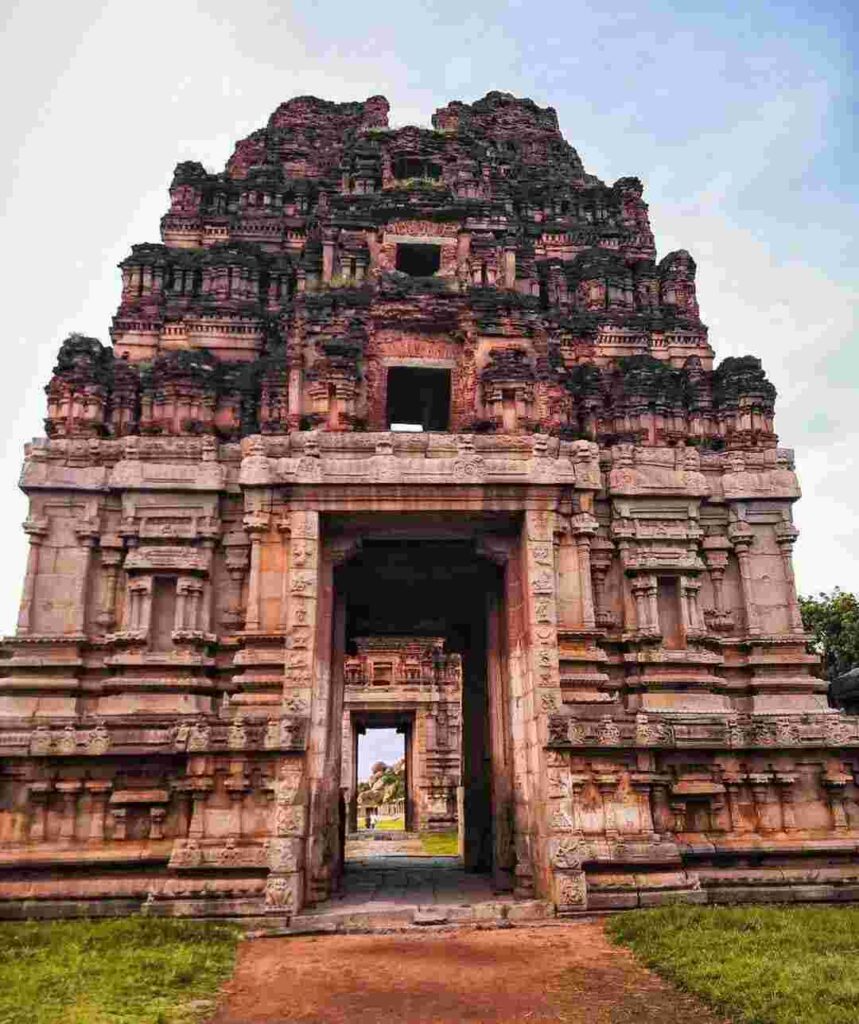
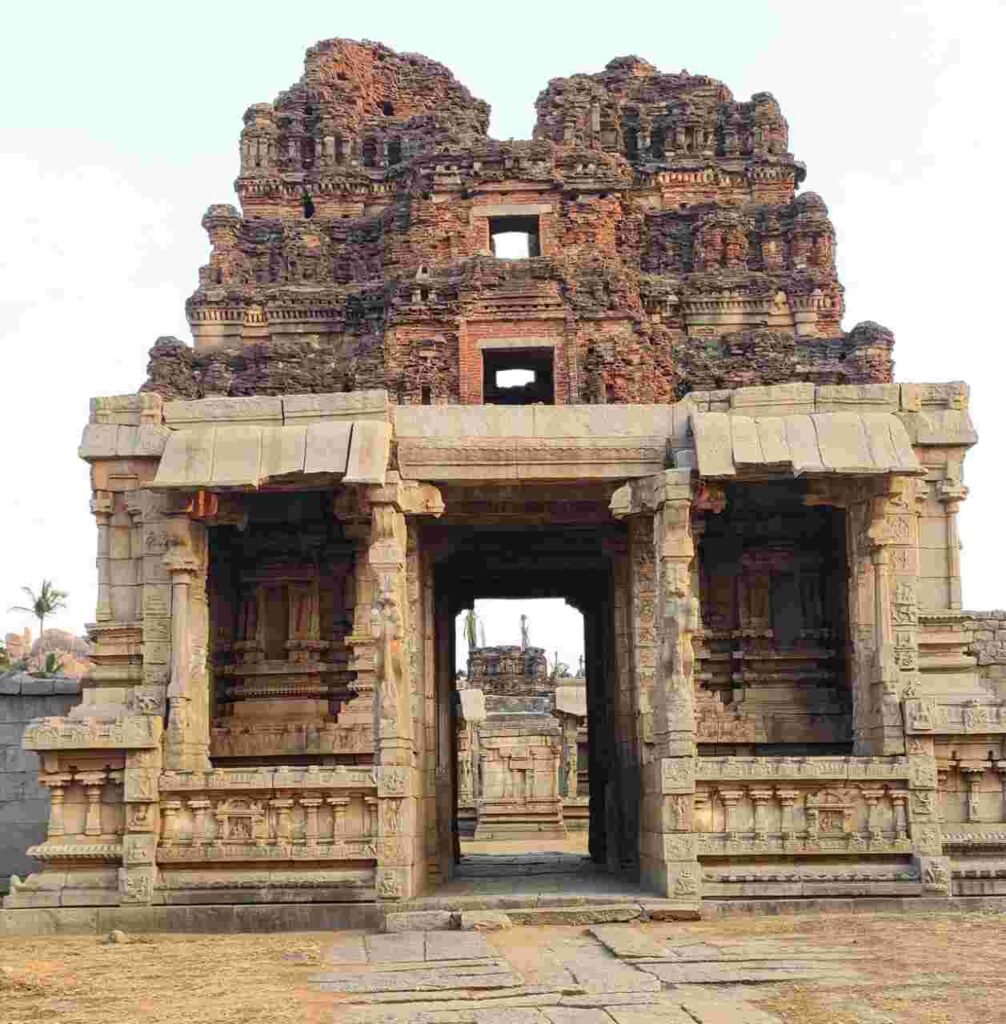

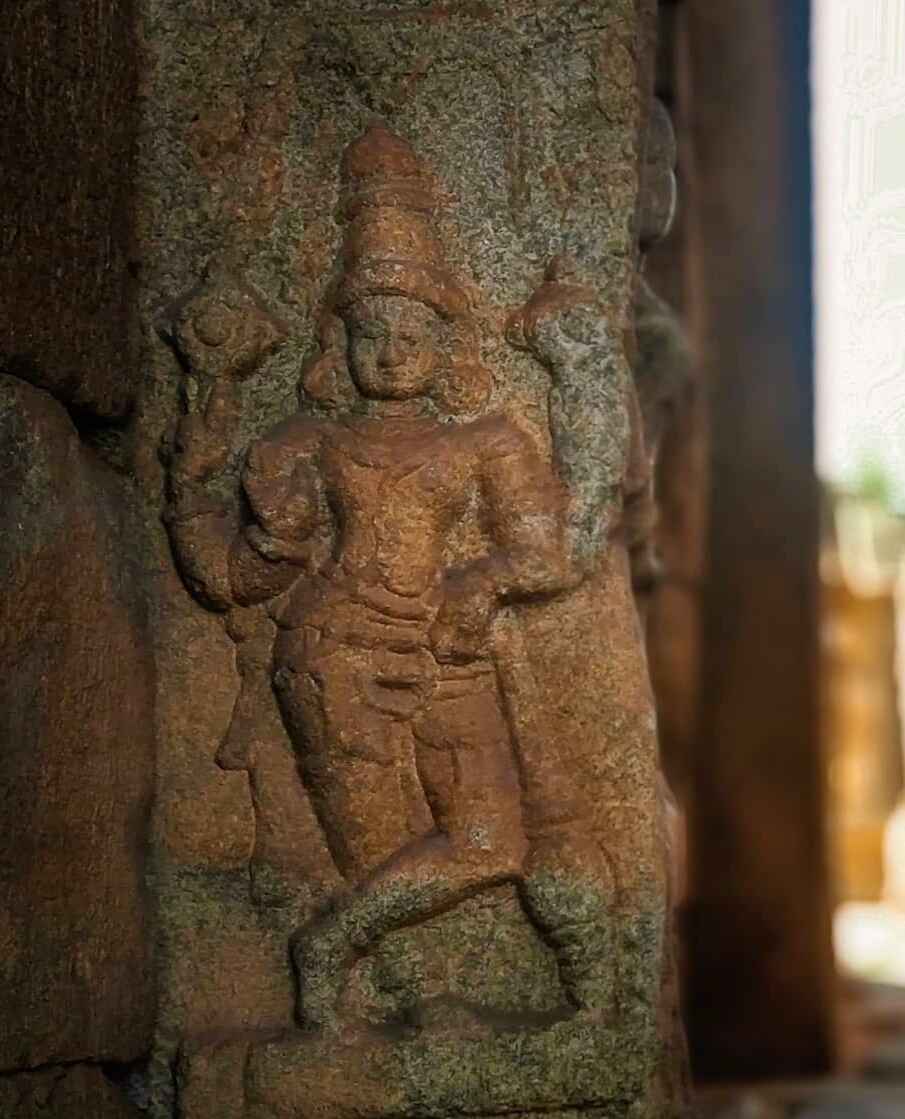
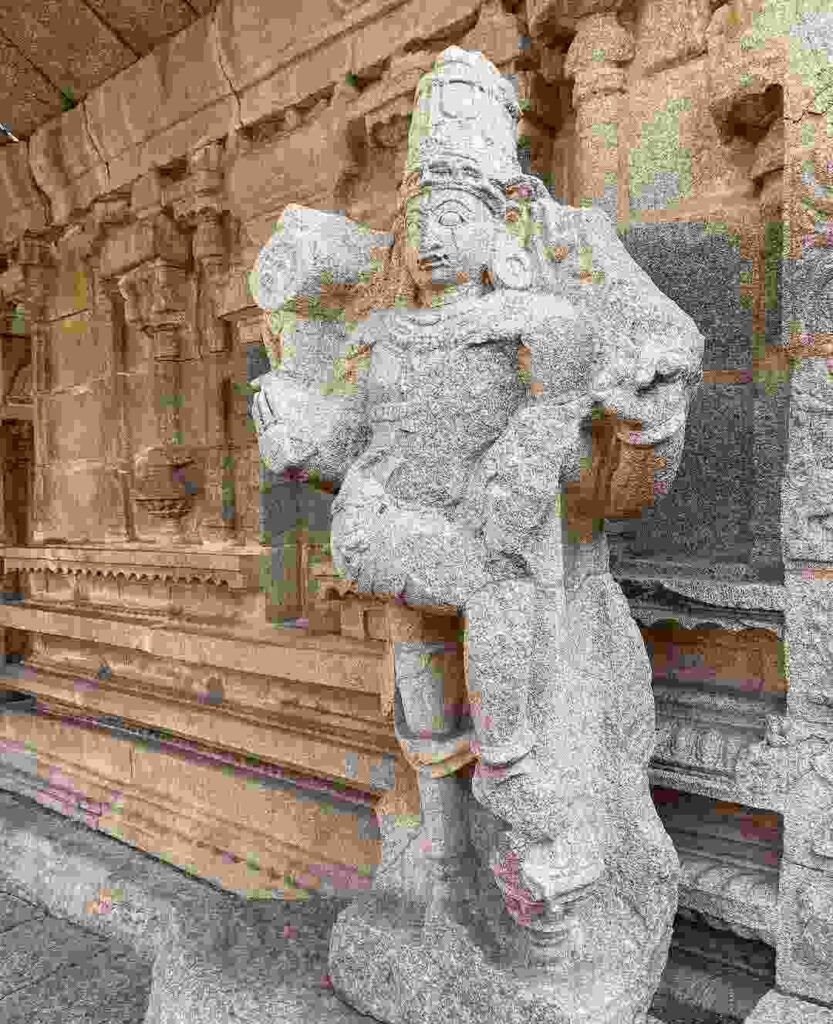

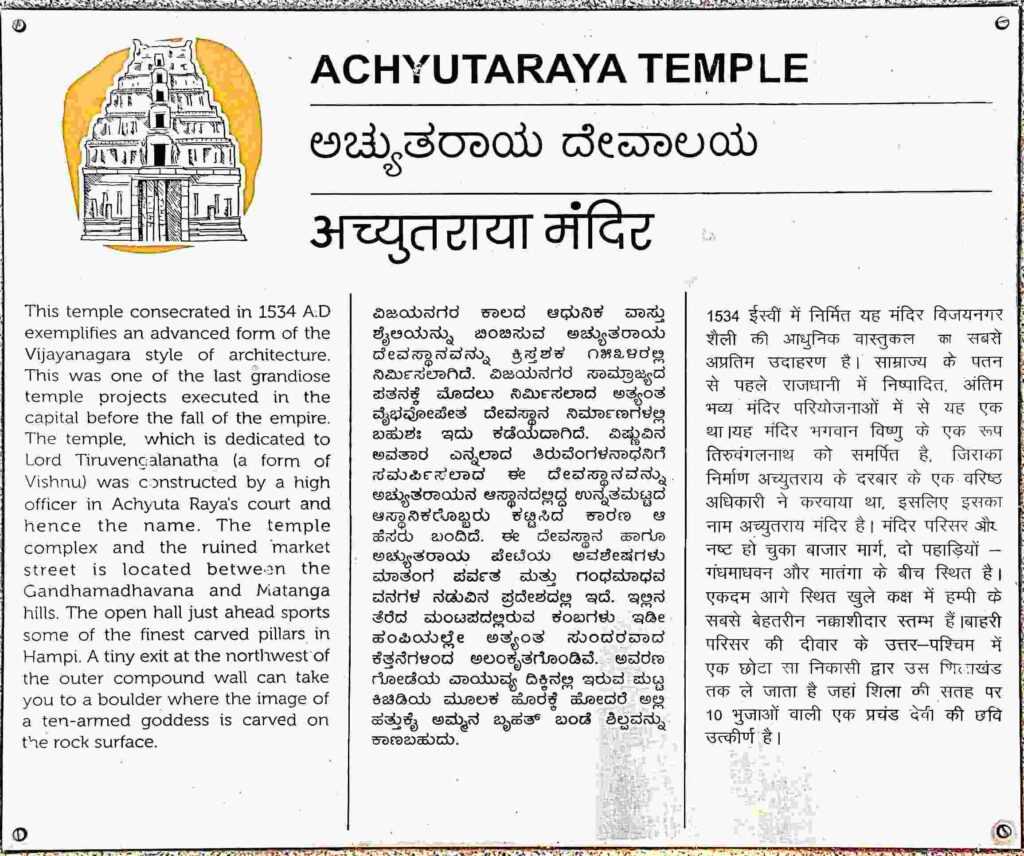
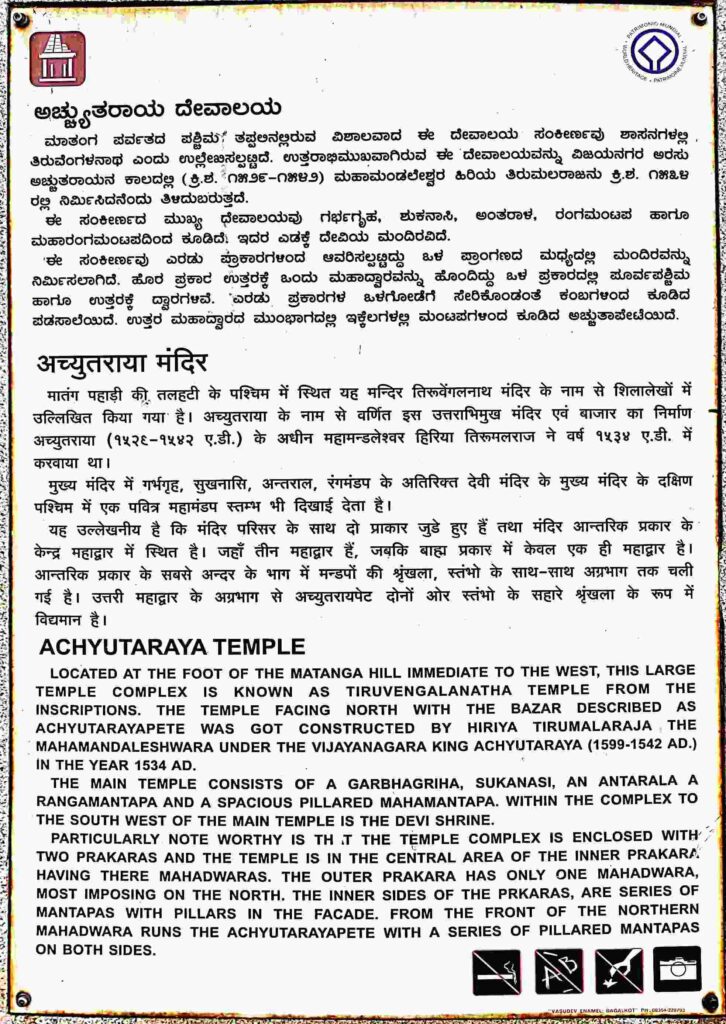


References:-
References from the Following Sources;
- ^[1] – History of Achyutaraya Temple was sourced from the ASI Information plaque located at the Achyutaraya Temple.
- ^[2] – Information about Achyutaraya Bazaar was sourced from the ASI Information plaque located at the Achyutaraya Bazaar.
- ^[3] – Information about Achyutaraya Temple Pushkarani was sourced from the ASI Information plaque located at the Achyutaraya Temple Pushkarani.